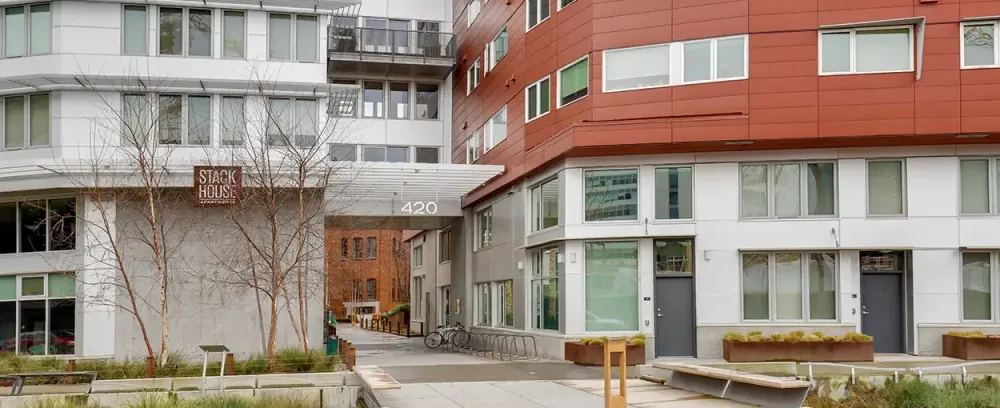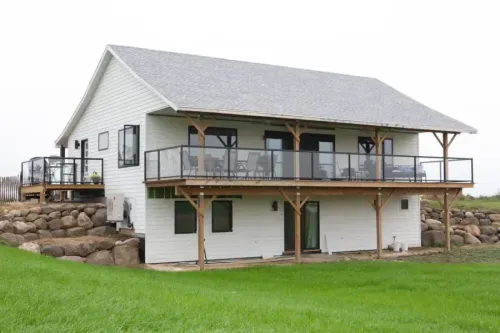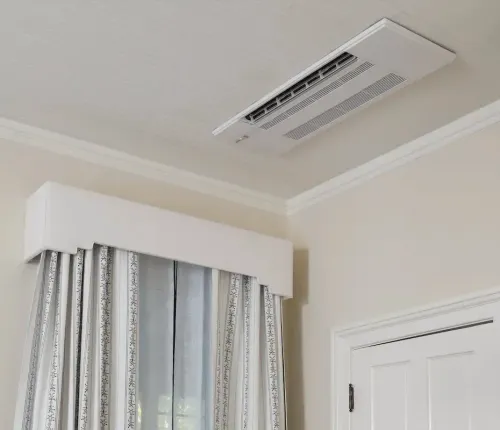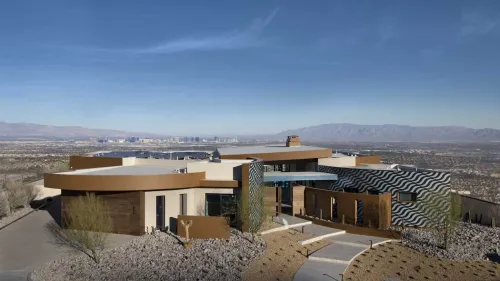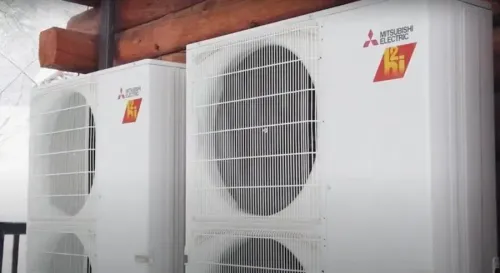Project Location: Seattle, Washington
Completion Date: July 2016
Challenge
Selecting an HVAC system efficient enough to meet rigorous energy efficiency standards and versatile enough to be used throughout a variety of spacesSolution
Mitsubishi Electric CITY MULTI® Variable Refrigerant Flow (VRF) SystemsResult
Quick-selling rental units and multiple recognitions, including LEED® Platinum certification
The Stack House Apartments (Stack House) is a development located in Seattle’s fast-growing South Lake Union neighborhood. The project’s three buildings cover an entire city block, offering market rate residential apartments and mixed-use spaces including offices, a restaurant and a gym. The development has won multiple certifications and recognitions for its innovative, energy-efficient design, as well as its actual performance. To name just one: LEED® Platinum certification. None of that would have been possible without Variable Refrigerant Flow (VRF) systems from Mitsubishi Electric.
Approximately three-quarters of the Stack House development was new construction resulting in two mid-rise multifamily facilities – one with 96 apartments across 96,000 square feet, the other 188 apartments across 198,000 square feet. The remaining one-quarter was an adaptive reuse of a laundry facility built in 1907, which was turned into a 39,000-square-foot building with commercial tenants.
Jon Heller, Pe, president, Ecotope, Inc., Seattle, was hired to provide HVAC and plumbing engineering services, energy efficiency consulting and energy performance modeling. He explained why only 40 percent of the apartment units were designed to have cooling and heating systems. “Traditionally, the Seattle climate has not necessitated cooling. So only apartment units facing south and west were selected to receive ductless heat pumps, as these apartments were going to get hot, and so have the highest seasonal cooling loads.”
Why zoned technology and VRF? Heller said, “Beyond the desire to be able to market cooling with some of the apartments, the desire to use ductless heat pumps was driven by this idea that the project was designed to hit energy-efficiency targets. We wanted to achieve a 60 percent reduction in energy use compared to the regional baseline. When we looked at Energy Use Intensity (Eui), we saw that the typical Seattle building at the time had an Eui of about 40. Our target was very aggressive – an average Eui of about 24. So ultimately, the selection was about performance and control. There’s really not any other way to deliver cooling close to this cost other than packaged terminal heat pumps, but those don’t deliver on performance. And we’d worked with ductless heat pumps before, so we knew the technology works.”
Melissa B. Wechsler, Aia, LEED Ap, principal, Runberg Architecture Group Pllc, Seattle, said, “It’s also great to have the ability to cool. The Seattle apartment market is really competitive. There’s a huge influx of people coming in, and the developers are always looking for ways to differentiate the products they’re offering. Mid-rise units, especially, are doing whatever they can to compete with high-rise units. Cooling is a really strong thing to be able to offer because high-rise buildings must have it since they can’t offer operable windows 20 stories up. So there’s this sweet spot for developers to take a mid-rise building and compete on amenities like cooling. That’s a real, tangible financial incentive.”
With zoned technology and VRF agreed on, attention turned toward Mitsubishi Electric. Heller said, “Mitsubishi Electric has the best product. It was the first manufacturer to come into the Seattle area, and it has strong product representation.” Mitsubishi Electric Zoned Comfort Solutions were designed for the two multifamily buildings; the historic commercial building’s restaurant and office spaces would receive Mitsubishi Electric VRF.
Installation went smoothly thanks to the flexibility of the Mitsubishi Electric equipment. For example, the two multifamily buildings’ rooftops had enough room for outdoor units, but the team wanted to retain a good deal of the space for amenities like a vegetable garden. To meet that need, some of the outdoor units were installed on the roof, the others in the parking garage. Wechsler noted that initially the team was also hesitant to put any kind of mechanical system on the rooftop next to amenities due to sound, “but the sound doesn’t seem to be a concern with these systems. They’re not that loud.”
The team also installed controls and Lossnay® Energy Recovery Ventilators (ERV). Heller said, “Wall-mounted programmable thermostats were installed in each [apartment] unit. In the commercial building, there’s the VRF controls system that can be monitored remotely. The ERVs serve the offices, restaurant and amenity spaces – the workout room, lobby lounge, theater and business center. We use the Lossnays to provide ventilation at very low energy.”
In addition to Mitsubishi Electric HVAC, other super-efficient features were installed, including a reverse cycle chiller for domestic water, Led light fixtures, energy-efficient appliances and windows, and low-flow water fixtures. The result is astounding. Heller said, “Beyond just achieving LEED Platinum, these apartments are among the most energy-efficient in the Pacific Northwest, with measured Eui’s of 19 kBtu/sf-yr for the West Building and 27 kBtu/sf-yr for the Southeast Building. That’s a major marketing point for the building, which helped it to fill up in a very short period of time. And the commercial building took part in Seattle’s pilot of an outcome-based energy code – the first program in the nation to predicate energy code compliance on post-occupancy proof of highly efficient operations. It’s an important, ambitious program, and we’re proud to have met it. The Mitsubishi Electric system was of course a part of that success.”
Colleen English, community manager, Greystar®, Dallas, oversees Stack House’s residential spaces. She has been pleased with the Mitsubishi Electric systems, as well. “Seattle summers are really hit or miss, but what’s interesting is that we have not needed a/c units until the last five to six years, really. And then last year we had another long summer, and we had a huge drought. The rental units that didn’t have a/c – they baked.” With such a stark situation, the value of having a cooling and heating system in the apartments was very apparent. “People’s expectations of what a home should provide are skyrocketing. People are just not going to spend thousands a month to not get a/c.” As a result, Stack House has been able to charge a rent premium on apartments with Mitsubishi Electric Zoned Comfort Solutions. Wechsler estimates that “based on the additional rent that management is recouping the system will pay for itself within the first five years.”
Such a successful, efficient project does not go unnoticed. Stack House has won a handful of certifications and recognitions, including: LEED for Homes Platinum certification; a 2016 ASHRAE Award, Category Vi-Residential; a 2015 Naiop Award for Preservation; 2015, 2014 and 2012 Gold Nugget awards, including the Grand Award (“Best Sustainable Residential Community”); and the 2013 Outstanding Multifamily Project of the Year for the 2013 LEED for Homes Awards.
The Stack House project’s success has also inspired other projects. Heller said, “The developer has continued to use the Mitsubishi Electric heat pump on other projects.” Likewise Wechsler said her team was impressed enough that they’ve turned to Mitsubishi Electric Zoned Comfort Solutions since. She said, “Mini-splits played a big role in Stack House’s success. So we have another project right now that uses the same Mitsubishi Electric mini-splits.”
Most recently, a Zoned Comfort Solution was installed in the Stack House property’s Winter Garden, or what English called “a greenhouse-style room – this awesome architectural element to the property that makes it individualized. There were plants and a seating area in there, but it was so intensely hot no one could use it. It was a nightmare. And the plants were all killed by the heat; we lost thousands of dollars in plant life. So we added a/c and turned the space into a game room. We have shuffle board, a ping pong table, furniture and a cactus garden. The Mitsubishi Electric equipment keeps it all nice and cool. Now, the space gets used daily.”
Project Team
- Property Management: Greystar®, Dallas, Texas
- Energy Efficiency and Mechanical Engineering Consultant: Ecotope, Inc., Seattle, Washington
- Architect: Runberg Architecture Group Pllc, Seattle, Washington
- Mechanical Engineer: Emerald Aire, Auburn, Washington
Mitsubishi Electric Equipment Installed
Commercial Building:
- (8) PUMY S-Series Outdoor Units
- (3) PUY P-Series Outdoor Units
- (3) PKA Wall-mounted Indoor Units
- (8) PKFY Wall-mounted Indoor Units
- (26) PLFY 4-Way Ceiling-cassette Indoor Units
- (26) PAR Deluxe MA Remote Controllers
- (4) Lossnay® Energy Recovery Ventilators
Multifamily Building:
- (95) MUZ M-Series Outdoor Units
- (3) PUMY S-Series Outdoor Units
- (3) PUY P-Series Outdoor Units
- (95) MSZ Wall-mounted Indoor Units
- (6) PKA Wall-mounted Indoor Units
- (15) PKFY Wall-mounted Indoor Units

